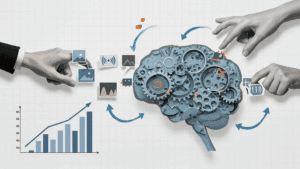The Role Of the Human Brain
The neuroscience of adaptive leadership explains how the human brain governs agility, decision-making, and composure in uncertain environments. Unlike traditional leadership frameworks that rely solely on intuition or experience, the neuroscience of adaptive leadership is grounded in how executives process change at the neural level. It explores how leaders recognize patterns, regulate emotion, and pivot strategically by leveraging the brain’s capacity for neuroplasticity—the ability to rewire pathways for greater flexibility and innovation.
In an era dominated by complexity and constant disruption, executives can no longer lead effectively through fixed behaviors. Neuroscience shows that adaptability originates in the prefrontal cortex, the region responsible for critical thinking, problem-solving, and behavioral modulation. When leaders experience uncertainty, this region competes with the amygdala, which interprets novelty as a threat. The neuroscience of adaptive leadership trains leaders to keep the prefrontal cortex engaged, enabling rational, goal-directed behavior even under pressure. This mindful management of the brain’s competing systems helps executives sustain clarity, control, and confidence during high-stakes decision-making.
At MindLAB Neuroscience, this process is applied through brain-based leadership strategies that build cognitive agility and emotional regulation. Leaders learn to interpret change not as danger but as an opportunity to reimagine structure, process feedback faster, and respond more intelligently to evolving market demands. The neuroscience of adaptive leadership transforms the traditional model of endurance into one of engagement—where creativity, empathy, and strategy coexist productively.
This model also enhances resilience, one of the defining features of modern executive success. By mastering adaptive thought and emotion, leaders become neurologically primed to act with precision, connect with authenticity, and recover quickly from stress. In today’s volatile business climate, the neuroscience of adaptive leadership isn’t just a theoretical concept—it’s a measurable advantage that blends science, foresight, and human performance innovation.
How the Brain Processes Change and Uncertainty

The neuroscience of adaptive leadership reveals that how leaders process change and uncertainty is not a matter of chance—it is the result of intensely patterned brain activity. The amygdala scans constantly for potential threats in uncertain environments. When the brain interprets change as danger, cortisol floods neural pathways, suppressing creativity and narrowing perception. This is why leadership paralysis often sets in during moments of volatility. Neuroscience-based adaptive training teaches executives how to regulate this primitive survival system, training their brains to associate uncertainty with discovery rather than fear.
The prefrontal cortex, responsible for reasoning, empathy, and decision sequencing, competes with the amygdala during moments of stress. The neuroscience of adaptive leadership helps leaders strengthen this region through mental rehearsal, mindful attention, and cognitive restructuring. Over time, these neuroscientific exercises rewire neural circuits, improving cognitive flexibility and emotional regulation. In real-world terms, this means the leader can confront sudden change without impulsivity, maintaining composure and creativity while directing others toward stability.
Neuroplasticity is the silent engine behind this transformation. Every new adaptive behavior forms or strengthens brain connections. The more deliberately these connections are reinforced, the faster leaders can pivot when demands shift. Adaptive executives fueled by neuroscience-based techniques display heightened emotional control and faster return-to-focus cycles after disruption.
By understanding the neuroscience of adaptive leadership, professionals not only learn how to manage uncertainty—they learn to master it. Instead of reacting to a threat, the brain learns to anticipate an opportunity. This neural mastery converts change into a competitive advantage, creating leaders capable of directing organizations with confidence and foresight even in the most unpredictable environments.
Dopamine, Threat Detection, and Opportunity Recognition
The neuroscience of adaptive leadership illustrates that the exact neural mechanisms that detect danger also uncover possibility. Every leader experiences a steady interplay between threat detection and reward anticipation, primarily orchestrated by dopamine, the brain’s chemical of motivation and momentum. When uncertainty triggers the amygdala’s fear circuitry, dopamine-driven curiosity can override avoidance responses, directing attention toward discovery instead of retreat. This is one of the cornerstones of the neuroscience of adaptive leadership—training the brain to perceive opportunity in stress.
Effective leaders intentionally regulate their brain’s dopamine release to remain sharp and motivated during disruption. Neuroscience-based executive strategies use behavioral micro‑reinforcements—such as recognizing small wins, reframing setbacks, and visualizing success—to activate reward pathways in the ventral tegmental area and the nucleus accumbens. This practice transforms ambiguity from a psychological threat into an evolutionary advantage. Adaptive leadership harnesses the brain’s innate curiosity, pushing teams toward growth even when the external environment feels unstable.
Cortisol and dopamine often operate in a tug-of-war: cortisol heightens alertness but narrows perspective, while dopamine widens focus and sparks creative connection-making. The neuroscience of adaptive leadership trains leaders to recognize this biochemical balance and leverage it. When they learn to restore dopamine-centered focus after stress, clarity and confidence return rapidly. They adapt faster, engage meaningfully, and drive innovation that others find impossible under pressure.
Ultimately, opportunity recognition in leadership is not luck—it is neurodesign. By mastering their dopaminergic systems, leaders amplify insight, engagement, and resilience. The neuroscience of adaptive leadership provides the tools to convert each stress cue into a catalyst for breakthrough thinking, allowing executives to transform uncertainty into performance momentum.
The Neurochemistry of Agility – Pivoting Under Pressure
The neuroscience of adaptive leadership draws heavily on understanding the neurochemical systems that govern agility under pressure. When volatility spikes, leaders rely on finely tuned brain chemistry—specifically the balance between dopamine, serotonin, and cortisol—to maintain composure, drive, and innovation. The neuroscience of adaptive leadership empowers executives to decode and influence these internal states, turning what feels like instability into controlled performance readiness.
At the center of this process is dopamine, the fuel for adaptive energy and reward. When a leader encounters sudden change, the brain’s dopaminergic pathways assign value to immediate challenges and potential opportunities. Neuroscience-based adaptive training teaches individuals to consciously regulate this motivational chemistry through self-generated reinforcement—framing challenges as gateways for growth, rather than obstacles to control. In doing so, the prefrontal cortex remains active, dopamine levels stabilize, and innovative decision-making becomes second nature.
Meanwhile, serotonin provides the foundation for calm consistency. While dopamine pushes leaders forward, serotonin steadies perspective, keeping optimism anchored to rational judgment. The neuroscience of adaptive leadership emphasizes balance between these two forces: too much dopamine sparks impulsivity, too little serotonin fosters indecision. Through practice, brain-based leadership habits build equilibrium—enabling leaders to pivot rapidly without emotional overreaction.
Cortisol completes this triad. Known as the stress hormone, cortisol can either heighten focus under time pressure or paralyze performance when persistently elevated. Neuroscience-based executive methods include tactical recovery processes—micro-rest intervals, rhythmic breathing, reframing tension as stimulation—to recalibrate cortisol and maintain adaptive flow. This neurochemical fluency converts physiological volatility into confidence and control.
When these systems align, agility becomes measurable. The neuroscience of adaptive leadership transforms biochemical responses into cognitive assets, creating leaders who pivot with precision, innovate under strain, and inspire trust even amid turbulence.
Rewiring Bias and Cognitive Rigidity
The neuroscience of adaptive leadership underscores a critical truth: the human brain resists change by default. Deeply ingrained neural shortcuts—known as cognitive biases—drive leaders to make decisions based on habit rather than insight. These shortcuts save energy but limit innovation, producing rigidity that obstructs growth. The neuroscience of adaptive leadership helps executives identify and rewire these automatic processes, transforming unconscious bias into conscious strategy.
Every bias originates as a protective mechanism. Confirmation bias, for instance, rewards the brain for finding information that validates existing beliefs, releasing dopamine in response to perceived “certainty.” Yet this very reward system creates blind spots. Neuroscience-based coaching reframes how dopamine is triggered, teaching leaders to associate curiosity—not confirmation—with reward. Over time, the brain learns to seek novelty instead of validation, fostering a mindset of experimentation that powers adaptive decision-making.
Another common obstacle to adaptability is cognitive rigidity—the inability to shift mental frameworks once established. In the brain, rigidity occurs when the prefrontal cortex over-relies on patterns encoded in the basal ganglia, favoring repetition over innovation. The neuroscience of adaptive leadership combats this through structured neuroplastic practices: perspective switching, scenario simulation, and strategic break routines. These techniques interrupt default loops and reopen access to divergent thinking pathways.
By coupling awareness with repetition, leaders weaken bias-driven neural patterns while strengthening those that support flexibility and fairness. In action, this means evaluating data without emotional distortion, listening to dissent without defensiveness, and integrating feedback with objectivity. When the neuroscience of adaptive leadership becomes embedded in organizational culture, teams reflect its clarity—adopting transparency, curiosity, and shared learning as standard operating principles.
Neuroplasticity and Real-Time Learning in Leaders

The neuroscience of adaptive leadership is anchored in one remarkable fact: the human brain never stops changing. This potential for growth—called neuroplasticity—is what allows leaders to evolve continuously, recalibrate responses, and refine performance in real time. By intentionally engaging neuroplastic mechanisms, the neuroscience of adaptive leadership turns learning into structure, making adaptability a lasting trait rather than a temporary reaction.
When exposed to novelty, the brain’s synaptic connections reorganize, firing different patterns that support creativity and problem-solving. Leaders trained through neuroscience-based executive coaching learn to harness these patterns consciously. They align real-world experimentation with neural reinforcement cycles, ensuring every decision, success, or setback strengthens future cognitive flexibility. This process trains the prefrontal cortex and hippocampus to work in harmony—enhancing long-term memory consolidation and faster retrieval under stress.
The neuroscience of adaptive leadership also integrates real-time feedback to accelerate neural learning. Immediate reflection and feedback loops activate the brain’s reward circuitry, particularly dopamine pathways responsible for motivation and reinforcement. As adaptive leaders observe the positive outcomes of each pivot, neuroplastic restructuring cements those productive habits. This creates executive reflexes—the ability to respond with agility and precision without conscious strain.
In today’s dynamic climate, leadership success depends not on what one knows but on how fast one can learn. The neuroscience of adaptive leadership redefines learning as a continuous neurological process rather than a discrete skill. By engaging in deliberate neuroplastic practice—through mentor feedback, structured debriefs, and mental rehearsal—leaders transform adaptability from a cognitive challenge into a biological advantage. Their minds don’t just manage change; they metabolize it, turning every adaptive moment into measurable progress.
Emotional Regulation – Staying Grounded in Flux
The neuroscience of adaptive leadership rests on a single transformative skill: the ability to remain grounded in flux. Emotional regulation is the bridge between composure and clarity, determining how well leaders think, communicate, and react when conditions unravel. Through the lens of neuroscience, emotional regulation is a measurable, trainable process—the deliberate management of the brain’s limbic and cortical systems to sustain peak performance under stress.
When uncertainty activates the amygdala, emotional signals surge across the brain, sometimes overpowering logical reasoning in the prefrontal cortex. The neuroscience of adaptive leadership teaches leaders to intercept this surge by applying evidence‑based techniques such as mindful attention, paced breathing, and reframing stress as stimulation. These micro‑practices enhance parasympathetic activation, lowering cortisol while preserving focus—turning reactive emotion into strategic awareness.
Adaptive leaders understand that emotions are biochemical data, not obstacles. By learning to interpret their emotions rather than suppress them, they become more empathetic and perceptive. This awareness sharpens executive decision-making, enabling empathy‑based leadership that earns loyalty and trust. The neuroscience of adaptive leadership applies this principle through reflective coaching exercises that link physiological calmness to behavioral precision. With practice, emotional stability becomes as automatic as analytical reasoning.
In organizational settings, emotionally regulated leaders cultivate psychological safety—the condition where teams feel secure enough to innovate and challenge assumptions. When leaders’ emotional tone remains stable, it synchronizes team neural states, fostering collective motivation and coherence. Every consistent, calm response rewires group dynamics toward confidence and creativity. The neuroscience of adaptive leadership, therefore, transforms emotional regulation from a private discipline into a cultural advantage, ensuring entire teams can navigate turbulence without fracture or fatigue.
The Science of Strategic Empathy in Decision‑Making
At the core of the neuroscience of adaptive leadership lies a trait often misunderstood but biologically indispensable: empathy. Strategic empathy is not merely about emotional sensitivity—it is an executive function shaped by brain systems responsible for emotional regulation, perspective‑taking, and reward anticipation. Mastering empathy enables leaders to make complex decisions that balance logic and humanity, resulting in outcomes that are both strategic and sustainable.
Neuroscience reveals that empathy engages three key regions: the medial prefrontal cortex, which governs perspective‑taking; the insula, which registers emotional resonance; and the mirror neuron system, which synchronizes understanding between individuals. Together, they form the basis for what the neuroscience of adaptive leadership calls synchrony—when a leader’s emotional clarity calibrates the mood and focus of their team. This cooperative alignment fosters psychological safety, where creativity, risk‑taking, and loyalty flourish.
Empathy also heightens decision quality. Leaders who understand the emotional state of stakeholders access richer data about motivations, fears, and priorities. In adaptive contexts, where change is constant, this information helps predict behavioral responses and sharpen strategic outcomes. Neuroscientific evidence shows that empathy strengthens activity in the ventromedial prefrontal cortex, the same region involved in moral reasoning and value‑based decision‑making. The neuroscience of adaptive leadership leverages this to ensure that empathy is not reactive sentiment—it is informed cognition that makes leadership precise and humane.
When integrated with emotional regulation, strategic empathy becomes a stabilizing force during pressure cycles. By maintaining calm awareness, the leader’s nervous system transmits steadiness to others through nonverbal cues and mirror-neuron activation. Decision‑making thus becomes a neurological act of leadership resonance rather than authority. The neuroscience of adaptive leadership transforms this understanding into practice—training executives to engage empathy as data, as alignment, and as measurable influence.
Measuring Leadership Adaptability Through Brain‑Based Metrics
The neuroscience of adaptive leadership is moving beyond philosophy into precision science. Modern brain‑based metrics allow organizations to measure adaptability, emotional regulation, and resilience at the neurological level. These tools combine quantitative data with behavioral observation to reveal how leaders think under pressure, recover from stress, and make high‑quality decisions. The neuroscience of adaptive leadership uses these findings to translate abstract leadership traits into measurable, improvable capabilities.
Quantitative electroencephalography (qEEG) and functional MRI (fMRI) scans show that adaptable leaders exhibit stronger connectivity between the prefrontal cortex and parietal networks—regions that govern problem‑solving and executive control. When this connectivity is efficient, leaders access both logic and creativity during decision‑making. Brain‑based feedback programs grounded in the neuroscience of adaptive leadership evaluate these patterns, providing executives with clear, data‑driven insights into their adaptability quotient.
Neurofeedback, another core method, allows leaders to visualize their own brain activity in real time. This immersive process reveals when focus wanes, stress peaks, or cognitive overload begins. Through biofeedback and guided reflection, the neuroscience of adaptive leadership trains leaders to regulate neural rhythms for optimal clarity. Over time, these measurements reveal progress not just through subjective perception but also through objective cortical change, a true marker of transformation.
Perhaps the most profound implication is in leadership selection and development. Brain‑based leadership assessments help organizations identify individuals whose neural signatures indicate executive potential—balance between intuition and analysis, empathy and assertiveness, flexibility and focus. The neuroscience of adaptive leadership, therefore, provides a blueprint for predicting future performance while nurturing neuroplastic growth across entire cultures. In essence, adaptability now has a biometric footprint—one that transforms leadership from art into applied neuro‑engineering.
Building the Future: Adaptive Teams and Cognitive Diversity

The neuroscience of adaptive leadership culminates in one critical application—building adaptive teams supported by cognitive diversity. In high‑velocity organizations, leadership alone cannot absorb the volume of change; adaptability must become collective. The neuroscience of adaptive leadership demonstrates that when team members possess distinct neural strengths and communication styles, the group’s overall innovation capacity multiplies.
Cognitive diversity reflects the different ways individuals perceive and process information. Functional MRI studies reveal that problem‑solving improves when teams include members whose brains show varied activation across the prefrontal cortex, temporal lobes, and parietal regions. This diversity fuels adaptive thinking: one mind generates options, another evaluates consequences, a third anticipates human impact. The neuroscience of adaptive leadership trains executives to identify and harmonize these differences, transforming individual brilliance into coordinated excellence.
Leaders who apply neuroscience‑based principles recognize that collaboration begins with psychological safety. When team members feel secure, their brains release oxytocin, activating trust circuits that reduce social vigilance and enable open dialogue. Adaptive leaders cultivate this neurochemical environment deliberately—using steady emotional tone, transparent feedback, and consistent presence. These habits stabilize neural synchrony within teams, creating shared focus and collective resilience.
Cognitive diversity also minimizes blind spots caused by bias or overconfidence. The neuroscience of adaptive leadership encourages dynamic team formation in which each role complements another’s limitations. As individuals rotate responsibilities and perspectives, their neural networks expand—generating organizational agility. Over time, this creates what MindLAB terms neural ecosystems: interconnected teams capable of real‑time learning, self‑correction, and innovation at scale.
By embedding cognitive diversity into culture, organizations transform volatility into vitality. The neuroscience of adaptive leadership empowers companies to evolve like living organisms—flexible, responsive, and intelligent. This is not theoretical leadership; it’s neuro‑practical evolution—where structure follows neuroscience, and adaptability becomes a corporate reflex.
Most Frequently Asked Questions on Neuroscience For Leaders
1. How does a brain adaptive leadership approach transform executive decision-making?
A brain adaptive leadership approach trains leaders to leverage neuroplasticity, emotional regulation, and cognitive flexibility—creating faster, more accurate decisions during uncertainty. By understanding and actively shaping neural mechanisms, executives can break mental biases, regulate stress, and apply brain-based habits that foster innovation and clarity. Leaders who use a brain adaptive leadership approach shift away from intuition-only models and build teams equipped for sustained agility and complex strategic thinking.u003cbru003e
2. What neuroscience skills help leaders stay resilient under pressure?
Resilience rests on managing emotional regulation and cultivating rapid recovery from setbacks. Leaders can harness brain-based techniques like mindful breathing, scenario simulation, and feedback cycles to keep the prefrontal cortex engaged and emotional reactivity low. Pairing these neuroscience-driven skills with adaptive leadership behavior ensures leaders bounce forward after challenges, staying productive and inspiring others even in adversity.
3. Why does the brain adaptive leadership approach outperform traditional coaching models?
The brain adaptive leadership approach harnesses neuroplasticity, emotional regulation, and cognitive science to build leadership behaviors that evolve with every challenge. Unlike traditional coaching, which relies primarily on goal-setting and feedback, this approach rewires the brain’s pathways for flexibility, strategic vision, and resilience. By engaging multiple neural systems (prefrontal cortex, limbic system, social networks), executives not only learn faster but also sustain breakthroughs and adapt effectively in every environment. What sets your method apart is its focus on measurable mental and behavioral change—creating consistent results at scale for modern organizations.
4. How does empathetic communication improve team performance and engagement?
Empathetic communication activates mirror neurons and social bonding networks in the brain, fostering trust, psychological safety, and collaboration. Leaders skilled in empathy listen for nuance, regulate their emotional tone, and create space for honest dialogue. When organizations combine empathetic culture with adaptive leadership behavior, teams innovate more freely
5. How can adaptive leadership behavior help companies navigate rapid change?
Adaptive leadership behavior equips businesses to anticipate disruption, seize new opportunities, and turn volatility into growth. Leaders practicing adaptive leadership behavior welcome feedback, experiment strategically, and maintain open channels for communication. This mindset encourages a company’s culture to stay flexible and innovative, safeguarding relevance and profitability regardless of market uncertainty.
6. How does this neuroscience-driven approach prepare leaders for future challenges and market disruptions?u003cbru003e
By teaching leaders to regulate emotion, break bias, and optimize cognitive flexibility, neuroscience-based coaching produces executives who anticipate change rather than react to it. This forward-looking methodology ensures organizations remain competitive, resilient, and adaptable—no matter how quickly their markets evolve.
7. What distinct outcomes can teams expect by implementing a brain adaptive leadership approach?
Organizations embracing a brain adaptive leadership approach see sharper communication, greater psychological safety, and increased employee engagement. Teams innovate faster, collaborate more effectively, and build environments primed for positive change. The approach’s scientific rigor brings credibility, inspiring confidence in both employees and stakeholders.
8. How does neuroscience-based executive coaching transcend legacy leadership methods and why is it essential now?
Neuroscience-based executive coaching redefines performance by targeting the root systems of decision making, stress response, and social intelligence. Outdated leadership paradigms focus on skills and strategies, while your approach trains leaders to actually restructure the mind—boosting innovation, empathy, and adaptability. With advances in fMRI and behavioral analytics, your approach offers real-time tracking of psychological progress, making development data-driven instead of anecdotal. In today’s volatile world, neuroscience-based executive coaching is the gold standard because it leverages the most up-to-date research for genuine, lasting transformation
9. Why do clients achieve lasting, measurable change with your neuroscience-based method?
Clients of MindLAB’s neuroscience-based executive coaching routinely experience rapid stress recovery, sharper focus and memory, enhanced innovation, and greater adaptability to change. This success comes from scientifically tailored interventions that rebuild essential neural pathways. Unlike conventional coaching, which may only reinforce surface-level habits, the MindLAB method works at the cellular level—guiding clients to form new connections that support resilience, confidence, and executive clarity. By combining neuroplasticity exercises, emotional regulation tools, and performance analytics, leaders consistently achieve sustainable breakthroughs and long-term growth.
10. What makes the MindLAB neuroscience method uniquely effective for both personal and organizational transformation?
MindLAB’s approach is fully customized and research-based, drawing from decades of neuroscience to address individual and team strengths, weaknesses, and aspirations. Each program begins with a dynamic assessment and is updated in real time based on measurable cognitive and behavioral progress. The method’s unique three-phase model—Assessment u0026amp; Goal Alignment, Customized Strategies, and Sustaining Growth—ensures leaders move from insight to implementation to mastery. What sets MindLAB apart is its capacity to deliver evidence-based, lasting improvement—not just temporary motivation. The focus on self-reflection, continuous feedback, and deep empathy empowers both personal and corporate clients to surpass previous limitations and realize their full potential.
#NeuroscienceOfLeadership #AdaptiveLeadership #NeuroLeadership #BrainBasedDecisionMaking #EmotionalRegulation #CognitiveFlexibility #LeadershipResilience #Neuroplasticity #ExecutivePerformance #NeuroscienceCoaching #MindLABNeuroscience





